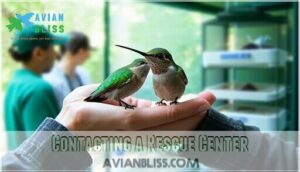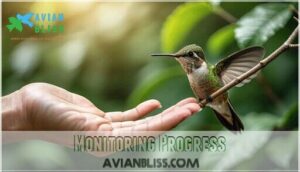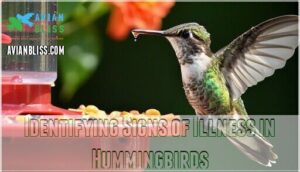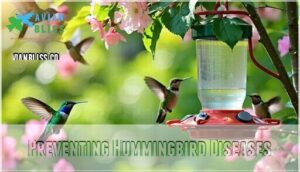This site is supported by our readers. We may earn a commission, at no cost to you, if you purchase through links.
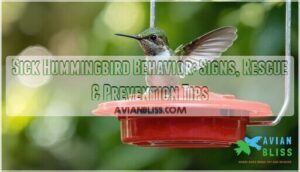
Look for telltale signs like prolonged sitting, drooping wings, difficulty flying, or unusual head positioning.
These tiny powerhouses rarely slow down unless something’s wrong.
A healthy hummingbird beats its wings 50-80 times per second, so lethargy means trouble.
You might spot one sitting motionless on a feeder, puffed up feathers indicating fever, or struggling to maintain balance.
Quick action saves lives—contact wildlife rehabilitators immediately, offer fresh sugar water, and create a quiet, warm environment.
Understanding these warning signals helps you become their unexpected guardian angel.
Quick response is crucial, as it can mean the difference between life and death for these delicate creatures, emphasizing the importance of quick action.
Table Of Contents
- Key Takeaways
- Recognizing Distress in Hummingbirds
- Steps to Assist a Sick Hummingbird
- Unusual Hummingbird Actions
- Understanding Hummingbirds Sitting on Feeders
- Identifying Signs of Illness in Hummingbirds
- Causes of Hummingbird Vocalizations
- Preventing Hummingbird Diseases
- Frequently Asked Questions (FAQs)
- How do you know if a hummingbird is sick?
- Are hummingbirds sick?
- Why is my hummingbird acting strangely?
- How do I help a sick hummingbird?
- How do you know if a hummingbird is dying?
- Do hummingbirds have abnormal behavior?
- How to help a sick hummingbird?
- What is an unusual hummingbird behavior?
- How do you know if a hummingbird is in torpor or dead?
- What does it mean when a hummingbird just sits on the feeder?
- Conclusion
Key Takeaways
- Watch for lethargy and unusual positioning – You’ll spot sick hummingbirds sitting motionless for extended periods, displaying drooping wings, or perching on the ground instead of their typical energetic flight patterns.
- Contact wildlife rehabilitators immediately – Don’t attempt to treat the bird yourself; licensed professionals have the specialized equipment and expertise needed to properly care for these delicate creatures.
- Provide emergency nectar and shelter – Mix one part white sugar with four parts water at room temperature, and create a quiet, dark environment using a ventilated box lined with soft tissue while waiting for professional help.
- Maintain clean feeders to prevent illness – Clean your feeders every 2-3 days with a 1:10 bleach solution and replace nectar every 48 hours to prevent bacterial growth and diseases like candidiasis.
Recognizing Distress in Hummingbirds
You might notice subtle changes in your hummingbird’s behavior that signal serious health problems.
Small behavioral changes in hummingbirds often signal life-threatening health emergencies requiring immediate attention.
Flight irregularities often appear first, with birds struggling to maintain steady movement or showing unsteady patterns. Breathing patterns become labored, and you’ll see them breathing with their beaks open, displaying clear respiratory distress.
Feather condition deteriorates, appearing dull, disheveled, or patchy, while their normal sleek appearance fades. Feeding reluctance becomes obvious when they stop visiting feeders regularly or struggle to maintain position while feeding.
Isolation signs include sitting alone for extended periods, avoiding interaction with other hummingbirds, and seeking solitary hideouts. Lethargy manifests as prolonged perching, inability to fly, and overall lack of energy.
These hummingbird symptoms indicate serious distress requiring immediate attention. Recognizing these sick hummingbird behavior patterns helps you respond quickly and contact wildlife rehabilitators for proper care.
Similarly, stressed hummingbirds may exhibit increased biting behavior, indicating fear or discomfort.
Steps to Assist a Sick Hummingbird
When you discover a sick hummingbird, swift action can make the difference between life and death.
Every second counts when a tiny life hangs in the balance.
You’ll need to balance immediate care with professional intervention to give these tiny birds their best chance at recovery**.
Contacting a Rescue Center
Once you’ve recognized distress signs, finding the right wildlife rescue becomes your lifeline.
Contact licensed wildlife rehabilitation centers immediately, as they possess specialized equipment and expertise for hummingbird care.
Follow these steps:
- Search rescue center criteria using directories like Animal Help Now or your state’s wildlife agency listings
- Prepare for transporting hummingbirds with a ventilated box lined with soft cloth
- Understand legal considerations since only licensed rehabilitators can legally treat wild birds
Finding the right supplies is key, so explore a wildlife rehabilitators list for essential resources.
Emergency situations require swift action—every minute counts for these tiny patients.
Providing Nectar Solution
Creating the perfect nectar solution can be the difference between life and death for a sick hummingbird.
Mix one part white granulated sugar with four parts water, ensuring it’s room temperature before offering. Never use honey, brown sugar, or artificial sweeteners, as these promote harmful fungal growth that can worsen your feathered friend’s condition.
Using refined white sugar is essential for the hummingbird’s health.
| Ingredient | Safe Options | Avoid |
|---|---|---|
| Sweetener | White granulated sugar | Honey, brown sugar, artificial sweeteners |
| Water | Filtered, boiled (cooled) | Tap water with chlorine |
| Temperature | Room temperature (70-75°F) | Hot or cold solutions |
| Storage | Refrigerate up to 48 hours | Room temperature storage |
Creating a Stress-Reducing Environment
When a hummingbird’s in distress, you’ll want to create a calm, undisturbed environment that mimics their natural hideouts.
Here’s your shoebox shelter checklist:
- Safe Shelter Setup – Line a small box with soft tissue and punch air holes
- Quiet Location – Choose a spot away from pets, children, and household noise
- Natural Perches – Add thin twigs or small branches for comfortable positioning
- Predator Protection – Keep the box covered and away from cats or other threats
- Minimal Handling – Resist the urge to peek frequently; let them rest undisturbed.
Consider using gentle tissue products for lining the box.
Monitoring Progress
Every fifteen minutes, check your hummingbird’s condition by watching for Recovery Signs like increased activity and improved Feather Condition.
Track these key indicators to monitor hummingbird recovery progress effectively.
| Recovery Indicator | Positive Signs | Concerning Signs |
|---|---|---|
| Behavior Changes | Active movement, alert posture | Continued lethargy, weakness |
| Nectar Consumption | Regular feeding visits | Refusing food, difficulty swallowing |
| Weight Fluctuation | Stable or gaining weight | Visible weight loss, protruding bones |
| Feather Condition | Smooth, well-groomed plumage | Ruffled, disheveled appearance |
Releasing in an Open Environment
Once your feathered patient shows signs of recovery, you’ll want to release it in an open area away from predators.
Choose a habitat suitability location with flowers nearby for immediate feeding opportunities.
Release timing matters—avoid windy or rainy conditions that could stress the bird.
Monitoring success from a distance helps guarantee your wildlife rehabilitation efforts paid off, giving this tiny warrior the best chance at freedom.
Unusual Hummingbird Actions
When spotting unusual sick hummingbird behavior, you’ll notice several alarming patterns that demand immediate attention.
Erratic flight patterns often signal neurological issues or exhaustion, while extended hovering without feeding suggests energy depletion.
Watch for these critical warning signs:
- Ground perching – healthy hummingbirds rarely sit on the ground
- Isolation behavior – withdrawing from other birds and normal activities
- Reduced feeding frequency at flowers or feeders
- Hummingbird lethargy – sitting motionless for extended periods
Hummingbird not flying properly indicates serious distress.
You might observe trembling, discharge from eyes or nostrils, or difficulty maintaining balance.
These symptoms require swift action – contact wildlife rehabilitators immediately.
Don’t attempt handling without proper guidance, as stressed hummingbirds can deteriorate rapidly.
Creating a quiet, dark environment while waiting for professional help gives these tiny warriors their best chance at recovery.
Understanding Hummingbirds Sitting on Feeders
Curiosity about feeder behavior can reveal important insights into your hummingbird’s health and habits.
When you notice a hummingbird sitting on feeders, you’re witnessing natural behaviors that serve multiple purposes, though prolonged perching warrants closer attention.
Normal reasons hummingbirds sit on feeders:
- Territorial Defense: Dominant birds guard prime feeding spots from competitors
- Energy Conservation: Strategic resting between high-energy feeding sessions
- Weather Response: Seeking warmth during cold mornings or shelter from wind
- Feeder Dominance: Establishing pecking order at popular feeding stations
- Torpor State: Brief rest periods to regulate body temperature
However, extended sitting can signal Exhaustion Signs or hummingbird illness.
Sick hummingbird behavior includes remaining motionless for hours, appearing fluffed up, or showing disinterest in feeding.
Normal territorial birds typically alternate between aggressive chasing and brief perching, while sick birds maintain static positions with drooped wings and closed eyes, indicating potential health concerns requiring immediate attention.
Identifying Signs of Illness in Hummingbirds
While some hummingbirds naturally perch on feeders, sick hummingbird behavior reveals distinct warning signs you shouldn’t ignore.
Hummingbird illness manifests through feather abnormalities like disheveled or matted plumage, which signals poor grooming ability. Watch for breathing difficulties such as open-mouth breathing or tail bobbing with each breath, indicating respiratory distress.
Feeding reluctance becomes obvious when birds hover near feeders but don’t actually drink, suggesting weakness or digestive issues. Posture changes include drooping wings, hunched shoulders, or sitting on the ground rather than perching upright.
Eye discharge or swelling around the beak points to infections requiring immediate attention. Hummingbird diseases like candidiasis create white lesions in the mouth, while aspergillosis causes gastrointestinal problems.
Sick hummingbird symptoms also include prolonged inactivity, trembling, and isolation from other birds. These hummingbird symptoms demand quick intervention to prevent fatal outcomes.
Annual checkups can help with early disease detection.
Causes of Hummingbird Vocalizations
You’ll notice that hummingbirds produce different sounds depending on their stress levels and health conditions.
These vocalizations help you identify when a bird might be experiencing distress or illness, as sick hummingbirds often change their typical calling patterns, which can be an indicator of their overall health.
Correlation of Vocalizations and Behavior
When you’re tuning into your hummingbird’s vocal expressions, you’re accessing a wealth of behavioral insights.
These tiny birds use Vocalization Meanings as nature’s telegraph system, revealing their emotional states and intentions through distinct Distress Calls, Territorial Signals, and Mating Songs that serve as essential Health Indicators.
- Territory Defense: Sharp, aggressive chirps signal boundary disputes
- Mating Calls: Melodic trills attract potential partners during breeding season
- Feeding: Soft chittering accompanies successful nectar gathering
- Alarm: High-pitched squeaks warn of approaching predators
- Social Interactions: Gentle warbles facilitate peaceful coexistence
Vocalizations in Stressful Situations
When stress strikes, you’ll notice your hummingbird’s vocalizations become more frequent and intense.
These acoustic stress signals serve as distress calls, alerting you to potential problems like predators, territorial disputes, or sick hummingbird behavior.
Understanding these distress call types helps you respond appropriately to their needs.
| Stress Level | Vocalization Frequency | Common Triggers |
|---|---|---|
| Low | Occasional chirps | Minor competition |
| Medium | Rapid chattering | Environmental noise |
| High | Continuous calls | Erratic breathing, isolation |
Sexual Dimorphism in Vocal Signals
Vocal Signal Differences between male and female hummingbirds reveal fascinating insights into sick hummingbird behavior.
Males produce more complex Sex-Specific Calls with broader frequency ranges, while females use simpler vocalizations primarily for nest defense.
During illness, these Dimorphic Song Complexity patterns change substantially.
Hormonal Vocal Control affects both sexes differently, with stressed birds showing altered Vocalization Functionality that can indicate health issues.
Preventing Hummingbird Diseases
You can substantially reduce your hummingbird’s risk of illness by maintaining clean feeders, avoiding window collisions, and creating a pesticide-free environment.
These simple prevention steps help protect these tiny birds from common diseases like candidiasis, salmonellosis, and injury-related complications.
Window Reflection Solutions
Windows create deadly traps when they reflect surroundings, fooling hummingbirds into thinking they can fly through glass.
Place decals with proper spacing—no more than 2 inches apart horizontally, 4 inches vertically—to prevent collisions.
External screens reduce strikes by 80%, while film options like frosted treatments outperform transparent visual markers.
Position feeders within 3 feet or beyond 30 feet of angled glass surfaces.
You can also consider UV-reflective window films for enhanced safety.
Planting More Flowers
Beyond window solutions, your garden can become a natural sanctuary for hummingbird health.
Attracting Pollinators through thoughtful Flower Diversity creates robust Habitat Enrichment that supports sick hummingbird behavior recovery. Native Species provide reliable Nectar Sources year-round, reducing dependency on artificial feeders that can harbor disease.
Consider these powerhouse plants for hummingbird care:
- Bee balm and cardinal flower – trumpet-shaped blooms perfect for hummingbird feeding
- Native salvias and penstemons – drought-tolerant options with extended flowering seasons
- Trumpet vine and honeysuckle – climbing varieties that maximize vertical space
This approach strengthens hummingbird health naturally.
Proper Feeder Maintenance
Proper feeder maintenance starts with understanding that hummingbird feeders require consistent care to prevent disease. Clean your feeders every 2-3 days in hot weather using a 1:10 bleach solution, ensuring feeder material hygiene through thorough scrubbing of hard-to-reach areas.
Avoiding contamination means using only white sugar (1:4 ratio) and replacing nectar before it spoils, while location impact matters—place feeders in shade to slow bacterial growth. Regular use of a hummingbird feeder cleaner is key to maintaining a healthy environment.
| Maintenance Task | Frequency | Health Impact |
|---|---|---|
| Deep cleaning with bleach | Every 2-3 days (hot weather) | Prevents 90% bacterial load |
| Nectar replacement | Every 48 hours | Stops mold development |
| Feeder inspection | Weekly | Catches early contamination |
| Brush scrubbing | Each cleaning | Removes hidden debris |
| Complete drying | After each wash | Prevents mold regrowth |
Frequently Asked Questions (FAQs)
How do you know if a hummingbird is sick?
A backyard hummingbird suddenly stopped visiting your feeders and now sits motionless on a branch, feathers ruffled and eyes closed – classic illness signs.
You’ll spot a sick hummingbird through lethargy, disheveled feathers, difficulty breathing, sitting for extended periods, refusing to feed, and unusual discharge from eyes or beak.
Are hummingbirds sick?
Individual hummingbirds can get sick, but healthy populations aren’t typically diseased.
You’ll spot illness through lethargy, disheveled feathers, difficulty flying, or discharge from eyes and beak.
Clean feeders prevent most diseases.
Why is my hummingbird acting strangely?
Strange hummingbird behavior often signals illness, exhaustion, or territorial disputes.
Watch for lethargy, sitting motionless, disheveled feathers, breathing difficulties, or reduced feeding.
Contact wildlife rehabilitators if symptoms persist beyond normal torpor.
How do I help a sick hummingbird?
When time’s ticking and you’ve spotted a struggling hummingbird, don’t panic—contact a wildlife rehabilitator immediately, offer homemade nectar (1:4 sugar-water ratio), and create a quiet, dark shelter while monitoring closely.
How do you know if a hummingbird is dying?
A dying hummingbird shows severe lethargy, sits motionless on the ground, breathes with its beak open, displays drooping wings, refuses food, and exhibits trembling or convulsions before death.
Do hummingbirds have abnormal behavior?
Like a puzzle missing pieces, hummingbirds display abnormal behavior when sick.
You’ll notice lethargy, disheveled feathers, difficulty flying, sitting motionless for extended periods, and reduced feeding frequency—clear signs something’s wrong, with lethargy and disheveled feathers being key indicators.
How to help a sick hummingbird?
Contact a wildlife rehabilitator immediately—don’t handle the bird yourself.
Offer homemade nectar (1:4 sugar-water ratio) with an eyedropper every twenty minutes.
Create a quiet, dark shelter using a shoebox while monitoring progress closely.
What is an unusual hummingbird behavior?
You’ll notice unusual hummingbird behavior when they’re sitting motionless on feeders for extended periods.
Breathing with their beaks open, or displaying disheveled feathers and lethargy instead of their typical energetic flight patterns.
How do you know if a hummingbird is in torpor or dead?
Still waters run deep" – check for breathing and response to gentle touch.
In torpor, you’ll see slight chest movement and the bird will react to warmth or touch, while a dead hummingbird shows no breathing or movement.
What does it mean when a hummingbird just sits on the feeder?
When a hummingbird sits on your feeder, it’s likely defending its territory from other birds or taking a rest break. However, prolonged sitting could indicate exhaustion or illness.
Conclusion
Have you ever wondered how such tiny creatures can signal their distress so clearly?
Recognizing sick hummingbird behavior isn’t just about spotting symptoms—it’s about becoming their lifeline when they need it most.
By maintaining clean feeders, providing fresh nectar, and creating bird-friendly environments, you’re preventing many health issues before they start.
Remember, these remarkable birds can’t ask for help, so your vigilance makes all the difference.
Watch for warning signs, act quickly when needed, and you’ll help these aerial acrobats thrive in your backyard sanctuary.
- https://6bc.org/sick-hummingbird-behavior-14-signs-to-look-out-for-what-you-can-do-to-help/
- https://www.wildliferescue.ca/2021/03/15/hummingbird-faq/
- https://www.ucdavis.edu/news/most-microbes-hummingbird-feeders
- https://www.reddit.com/r/hummingbirds/comments/ufifyr/curious_behavior_from_a_hummingbird_sick/
- https://www.birdforum.net/threads/hummingbird-normal-behavior-or-sick.438983/

